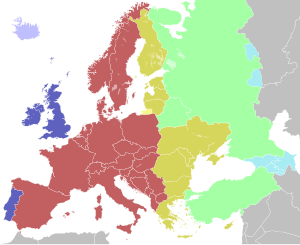Central European Midsummer Time (CEMT) was a time zone three hours ahead of GMT, used as a double summer time in several European countries during the 1940s.

| Light Blue | Western European Time / Greenwich Mean Time (UTC) |
| Blue | Western European Time / Greenwich Mean Time (UTC) |
| Western European Summer Time / British Summer Time / Irish Standard Time (UTC+1) | |
| Red | Central European Time (UTC+1) |
| Central European Summer Time (UTC+2) | |
| Yellow | Eastern European Time / Kaliningrad Time (UTC+2) |
| Ochre | Eastern European Time (UTC+2) |
| Eastern European Summer Time (UTC+3) | |
| Green | Moscow Time / Turkey Time (UTC+3) |
| Turquoise | Armenia Time / Azerbaijan Time / Georgia Time / Samara Time (UTC+4) |
▉▉▉ Dark colours: Summer time observed
Usage
editFrance
editSome parts of France, but not Paris, observed Central European Midsummer Time in 1941–1945.
Germany
editCentral European Midsummer Time was used in occupied Germany from 11 May, 03:00 CEST to 29 June 1947, 03:00 CEMT.
According to GHEP,[1] Berlin and the Soviet Occupation Zone observed midsummer time from 24 May 1945, 02:00 CET to 24 September 1945, 03:00 CEMT. Midsummer time was equivalent to Moscow Time, which did not observe DST then.[2]
See also
editNotes
edit- ^ Grimm, Hoffmann, Ebertin, Puettjer, Die Geographischen Positionen Europas, Ebertin-Verlag, Freiburg 1994 (GHEP)
- ^ DST and midsummer DST in Germany until 1979 (PTB, National Metrology Institute of Germany, accessed: 2 March 2021)